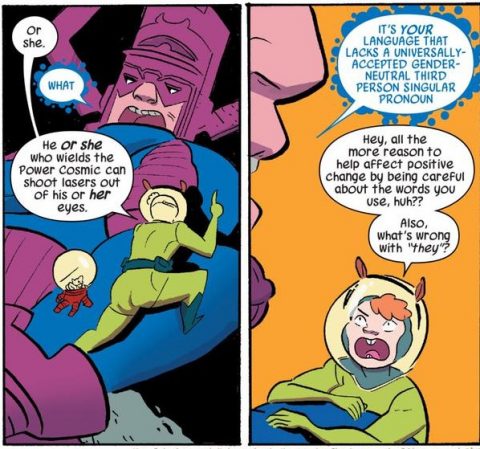Want to see what other comic books I read each month? Well, look no further: One Shots is my weekly comic book round-up, covering everything I can’t get to in my regular reviews. This week I’ll be covering books from Image Comics, Titan Comics, and Marvel Comics, so prepare your face for some rapid fire reviews!
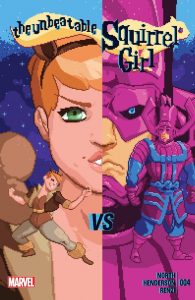 Unbeatable Squirrel Girl #4
Unbeatable Squirrel Girl #4
Scripter: Ryan North
Artist: Erica Henderson with Chris Giarusso
Colorist: Rico Renzi
Score: 4 out of 5 Stars
It’s hard not to love Unbeatable Squirrel Girl from Ryan North and Erica Henderson. This all-ages book is upbeat, funny, and packed with subtle social commentary that never patronizes its readers. In its fourth issue, our favorite squirrel-themed hero finally squares off against Galactus in a supremely silly plot, complete with a pixelated fighting game-inspired cover, reaching an equally silly conclusion. This is the impossible fight you’ve been waiting for, told in a self-aware and non-linear format, with an amusing ending to tie everything all up.
While the book is known primarily for its sense of humor, North’s scripting provides surprisingly human and interesting characters. He brings Galactus down to Squirrel Girl’s level through their endearing banter, making for several genuinely funny sequences that humanize Galactus without making him into a joke. Henderson’s whimsical visuals respect the scope and gravity of the face-off without sacrificing the visual humor, and as ever Renzi’s effervescent palette choices are a perfect match for the book’s tone.
And of course, we can’t forget about this:
If you’re not reading Unbeatable Squirrel Girl, you’re missing out.
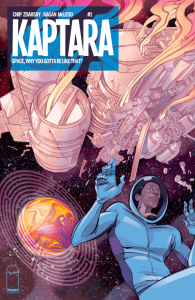 Kaptara #1
Kaptara #1
Scripter: Chip Zdarsky
Artist: Kagan McLeod
Score: 4 out of 5 Stars
Talking about science fiction in comic books usually conjures up some very specific definitions. By and large, I think we’re used to two kinds of comic book science fiction from mainstream publishers: the fun and tropey adventure space opera, and the heavy, Kubrick-esque allegory. It’s usually laser guns or metaphysical questioning, with little gray area in between. Kaptara #1 from Chip Zdarsky and Kagan McLeod strives to find that gray area and use it to its advantage.
By all accounts, Kaptara is a bit of a weird book. The cover subtle “Space, Why You Gotta Be Like That?” sets the tone for the story irreverent that follows. It’s a mash-up of pulp sci-fi convention with the slick aesthetic and polish we’ve come expect after one too many space exploration movies. It’s what happens when Barberella and classic Star Trek invades Sunshine and Solaris, complete with furry boots and giant space monsters. And more than that, it works surprisingly well.
Kaptara stars Keith Kanga, a promising young scientist whose aunt’s name emblazons the side of the ship. Keith is smart, but he’s young, scrawny, and unprepared for the rigors of space travel, spending the first few pages whining about the mission that he begged his aunt to go on. He’s almost immediately unlikeable, something of a Holden Caulfield character, who covers up his fears and inadequacies with an obnoxious sense of humor. Keith is also an openly gay Indian man, in a crew comprised almost entirely of men and women of color, making for a welcomingly diverse cast.
When the crew is forced to jettison the escape pods, Keith finds himself stranded alone on the planet Kaptara, beautifully rendered by artist McLeod. Totally unprepared, he’s quickly overwhelmed by the dangers of the harsh alien landscape, only to be rescued by an unlikely friend. Keith then wakes up in an elaborate facility, populated by characters and creatures right out of a classic pulp adventure comic, complete with the extravagant costuming and décor of your average alien court. Taken in by the aliens, Keith quickly loses his affections for Earth and decides to stay on Kaptara as Keith, Prince of the Dance Floor.
Zdarsky and McLeod deliver a smart, sharply funny sci-fi adventure. While Zdarsky’s dialogue is a little cluttered with pop culture references, his characters are remarkably well-developed. Keith is an entertainingly unlikeable protagonist, too snarky and selfish for his own good, but with an added layer of depth that promises to make for an interesting arc. McLeod’s artwork is just lovely, with long, elegantly constructed figures and highly detailed organic backgrounds. The action sequences are tense and energetic, balancing the two-person dialogue exchanges that make up the bulk of the issue. His palette choices are bold and lively, painting alien landscapes and creatures with the oranges, teals, and magentas right out of an episode of Star Trek.
Overall, Kaptara #1 is fun. It’s offbeat, cheeky, and uses humor to disguise the heart that lurks underneath, despite Keith’s best efforts to keep it hidden. This is definitely a book worth picking up.
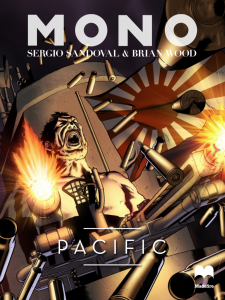 MONO: Pacific #1
MONO: Pacific #1
Scripter: Brian Wood
Artist: Sergio Sandoval
Colorist: Diego Rodriguez
Score: 3 out of 5 Stars
The ape-human hybrid Mono is back in the service of Queen and country in MONO: Pacific #1 from Brian Wood and Sergio Sandoval. Sequel to MONO: The Old Curiosity Shop by Ben Wolstenholme and Liam Sharp, this two-part story follows British secret agent Mono on a mission to locate a secret Japanese submarine base during World War II. There Mono encounters modified ape soldiers in fast-paced jungle combat sequences, narrated in the style of handwritten journal entries documenting Mono’s travels. Infusing pulp comic convention with elements of sci-fi and fantasy, this two-parter offers an entertaining spin on World War II fiction.
Artist Sergio Sandoval’s confident style and well-composed panels deliver tight, tense action sequences and impressive jungle scenes. His finely detailed figure work makes good use of the notable physical differences between Mono, the ape soldiers, and the humans he sporadically encounters. This effectively accentuates Mono’s hybridity through subtle facial structure and body fur without making him too ape-like. Mono is clearly somewhere in between man and ape, both in his appearance and physicality, at home among neither species.
Writer Brian Wood crafts a solid script but his dialogue is stiff and clunky compared to the box narration. The narration is a bit more formal, expressed as journal entries written after the events of the story, but does a far better job of conveying Mono’s voice than the cheesy turns of phrase peppered throughout. It’s rare that I favor box narration to spontaneous or conversational dialogue, but here the book would be better served by the protagonist’s silence.
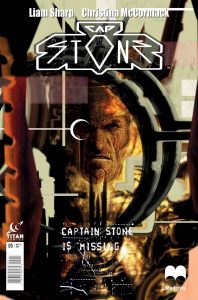 Captain Stone is Missing #5
Captain Stone is Missing #5
Scripter: Christina McCormack and Liam Sharp
Artist: Liam Sharp
Score: 4.5 out of 5 Stars
I hadn’t heard of this series before it crossed my desk earlier this week. It’s rare for me to review an issue from an ongoing I don’t keep up with, but this time I made an exception. And I was glad that I was. A visually dense and absorbing treatment of superhero genre conventions, echoing the impressive storytelling styles of 1980s comics from the likes of Jon J. Muth, Kent Williams, and Bill Sienkiewicz, Captain Stone is Missing is one of the most intriguing books I’ve come across in recent months.
Artist Liam Sharp changes techniques and palettes as quickly as he and co-writer Christian McCormack switch scenes, demonstrating an impressive stylistic diversity. Tight claustrophobic panel compositions, loose scrawling figure work, and deep red tones effuse a sense of horror in the opening pages, before shifting to dreamy beige-tinged splashes and heavily textured digital collage. The underground hideouts of superheroes are cavernous spaces, expansive stone cathedrals occupied by aging steelwork and technology like alien space crafts.
Sharp’s angularly-composed female forms are evocative of fashion design, constructed in long elegant lines, loose hair flowing over oblique features. The characters are timeless, the scenes are otherworldly, and every page feels like a nostalgic romp through some of the best 80s and 90s comics had to offer. Given that Sharp got his start in the 80s the visual complexity of the book makes sense, calling back to some of my favorite books and creators at a time when artists took chances with style and storytelling. A beautiful and engrossing read from start to finish, Captain Stone is Missing #5 makes me want to find the rest of this series and devour it as quickly as possible.


